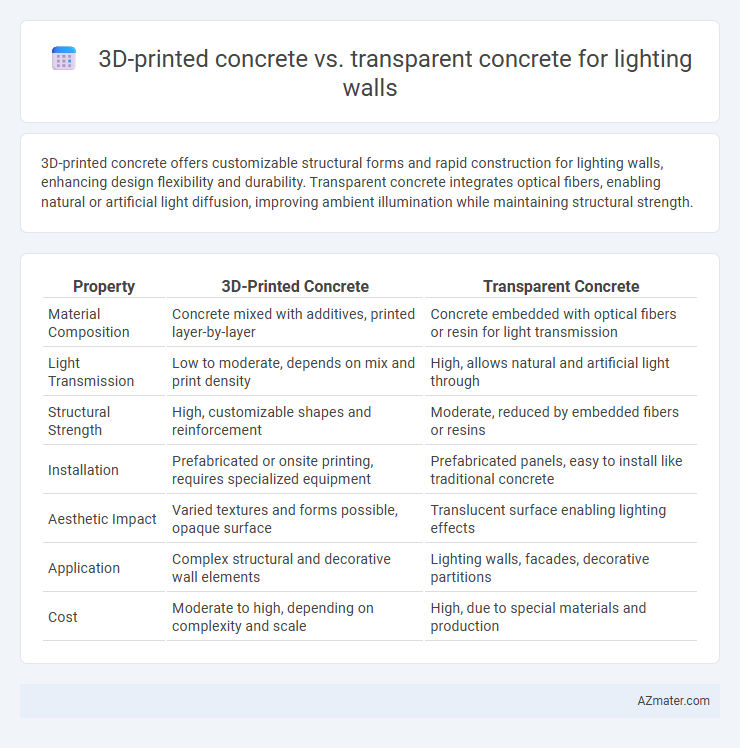3D-printed concrete offers customizable structural forms and rapid construction for lighting walls, enhancing design flexibility and durability. Transparent concrete integrates optical fibers, enabling natural or artificial light diffusion, improving ambient illumination while maintaining structural strength.
Table of Comparison
| Property | 3D-Printed Concrete | Transparent Concrete |
|---|---|---|
| Material Composition | Concrete mixed with additives, printed layer-by-layer | Concrete embedded with optical fibers or resin for light transmission |
| Light Transmission | Low to moderate, depends on mix and print density | High, allows natural and artificial light through |
| Structural Strength | High, customizable shapes and reinforcement | Moderate, reduced by embedded fibers or resins |
| Installation | Prefabricated or onsite printing, requires specialized equipment | Prefabricated panels, easy to install like traditional concrete |
| Aesthetic Impact | Varied textures and forms possible, opaque surface | Translucent surface enabling lighting effects |
| Application | Complex structural and decorative wall elements | Lighting walls, facades, decorative partitions |
| Cost | Moderate to high, depending on complexity and scale | High, due to special materials and production |
Introduction to Innovative Concrete Materials for Lighting Walls
3D-printed concrete offers precise structural customization and efficient material use, making it ideal for creating complex lighting wall designs with integrated channels for LED systems. Transparent concrete incorporates optical fibers that transmit natural or artificial light, producing visually dynamic walls that enhance ambient lighting without compromising strength. Both materials represent cutting-edge advancements in architectural innovation, combining functionality, aesthetics, and energy efficiency for modern lighting walls.
Understanding 3D-Printed Concrete Technology
3D-printed concrete technology involves layer-by-layer extrusion of specially formulated concrete mixes, enabling precise control over wall geometry, texture, and structural integrity ideal for complex lighting wall designs. Unlike transparent concrete, which incorporates optical fibers or resins to transmit light and enhance aesthetics, 3D-printed concrete focuses on customization and efficiency in construction with digital modeling techniques. This technology supports sustainable construction practices through material optimization and reduces waste while allowing integration of lighting elements within the 3D-printed framework.
Exploring Transparent Concrete and Its Properties
Transparent concrete incorporates optical fibers or resin-based materials, allowing light to pass through while maintaining structural integrity, making it ideal for innovative lighting walls. It offers a unique combination of translucency and strength, providing natural daylighting, aesthetic appeal, and energy efficiency in architectural applications. Unlike 3D-printed concrete, which emphasizes customizable shapes and rapid construction, transparent concrete focuses on light transmission properties, enhancing ambiance without sacrificing durability.
Aesthetics: Visual Impact of 3D-Printed vs Transparent Concrete Walls
3D-printed concrete walls offer intricate geometric patterns and customizable textures that create striking visual depth and modern architectural appeal, enhancing lighting effects through shadow play. Transparent concrete walls incorporate optical fibers or aggregates that transmit natural or artificial light, producing a luminous, ethereal glow that transforms interiors with a unique light diffusion. The choice between 3D-printed and transparent concrete depends on desired aesthetics: bold texture and form versus subtle light integration and translucency for lighting walls.
Light Transmission Capabilities Compared
3D-printed concrete offers customizable structural designs but has limited light transmission capabilities due to its dense, opaque composition. Transparent concrete, embedded with optical fibers or resin, enables significant light diffusion, allowing natural or artificial light to permeate interior spaces effectively. This makes transparent concrete more suitable for lighting walls where maximizing light transmission and aesthetic appeal are critical.
Structural Performance and Durability
3D-printed concrete offers superior structural performance due to its ability to create complex, load-bearing geometries with consistent layer adhesion, enhancing overall strength and resilience. Transparent concrete, embedded with optical fibers or resin-based elements, provides moderate structural integrity but excels in diffusing natural light, often requiring reinforcement to meet durability standards. Both materials demonstrate unique durability profiles, where 3D-printed concrete withstands environmental stressors through optimized mix designs, while transparent concrete's longevity depends on fiber quality and protective coatings to prevent degradation.
Sustainability and Environmental Considerations
3D-printed concrete offers sustainability benefits through reduced material waste, lower carbon emissions due to precise layering, and the ability to incorporate recycled aggregates, making it an eco-friendly option for lighting walls. Transparent concrete, integrating optical fibers or translucent aggregates, enhances natural light penetration, reducing reliance on artificial lighting and lowering energy consumption, thus promoting environmental efficiency. Both materials contribute to sustainable building practices by optimizing resource use, with 3D printing emphasizing material efficiency and transparent concrete focusing on energy savings.
Cost Analysis: Production and Installation
3D-printed concrete offers cost advantages in production and installation due to automation, reduced labor, and minimal material waste, lowering overall project expenses for lighting walls. Transparent concrete, incorporating optical fibers or resin-based elements, incurs higher costs from specialized materials and complex fabrication techniques, increasing both manufacturing and installation time. For lighting wall applications, 3D-printed concrete provides a more economical solution, while transparent concrete demands premium investment for its unique light-transmitting properties.
Ideal Use Cases for Lighting Walls
3D-printed concrete excels in creating complex, customizable lighting walls with integrated channels for LED placement, making it ideal for architectural facades requiring intricate designs and efficient light diffusion. Transparent concrete, embedded with optical fibers, is best suited for applications needing natural light transmission while maintaining structural integrity, such as decorative interior partitions or exterior walls in daylight harvesting systems. Both materials support innovative lighting solutions, but 3D-printed concrete offers greater flexibility for dynamic, programmable light effects in urban or commercial settings.
Future Trends in Concrete Technology for Architectural Lighting
3D-printed concrete enables intricate, customizable lighting wall designs with enhanced structural precision and reduced material waste, supporting sustainable architectural innovations. Transparent concrete integrates optical fibers or resin, allowing natural light diffusion through wall surfaces, promoting energy-efficient daylighting. Future trends focus on combining these technologies to create adaptive facades that optimize light transmission while offering robust structural capabilities and aesthetic versatility in architectural lighting.

Infographic: 3D-printed concrete vs Transparent concrete for Lighting wall
 azmater.com
azmater.com